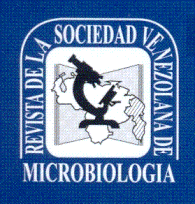Determinación del gen que codifica la enzima APH-(3´)-VIa en aislamientos de Acinetobacter 13TU:RUH1139 de origen hospitalario
Palabras clave:
Acinetobacter 13TU, RUH 1139, aminoglucósidos, aph-(3’)-VIa, aminoglucosidesResumen
Resumen: El objetivo de este trabajo fue evaluar el fenotipo de resistencia y la presencia del gen aminoglucósido-O-fosfotransferasa-3´-VIa (aph-(3´)-VIa) en 23 aislamientos identificados como Acinetobacter 13TU:RUH 1139, provenientes de neonatos y soluciones parenterales, administradas a los mismos, en la Unidad de Alto Riesgo Neonatal (UARN) del Instituto Autónomo Hospital Universitario de Los Andes (IAHULA). Para la determinación de la susceptibilidad antimicrobiana se probaron seis aminoglucósidos mediante la prueba de difusión en agar (amikacina, gentamicina, tobramicina, netilmicina, dibekacina y neomicina), así como kanamicina y estreptomicina por dilución en agar. Todos los aislamientos resultaron resistentes a estreptomicina, más del 90% de los mismos mostraron resistencia ante amikacina, gentamicina y tobramicina, y el 82,6% fue resistente a netilmicina y dibekacina. Se detectó el gen aph-(3´)-VIa en 15 aislamientos de los neonatos y en 2 provenientes de las soluciones parenterales. Debido al elevado porcentaje de aislamientos resistentes a los aminoglucósidos, así como la presencia del gen aph-(3´)-VIa en Acinetobacter 13TU:RUH 1139, el uso de estos antimicrobianos como monoterapia debe ser restringido en el IAHULA y es necesario vigilar continuamente la diseminación genética de dicha resistencia.
Determination of the gene which codifies the APH-(3’)-VIa enzyme in Acinetobacter 13TU:RUH1139 isolates of nosocomial origin
Abstract: The purpose of this work was to evaluate the resistance phenotype and the presence of aminoglucoside-0-phosphotransferase-3’-VIa (aph-(3’)-VIa) in 23 isolates identified as Acinetobacter 12TU:RUH 1139, obtained from neonates and parenteral solutions administered to them, at the Neonatal High Risk Unit (NHRU) of the Instituto Autónomo Hospital Universitario de Los Andes (IAHULA). Six aminoglucosides were examined for determination of antimicrobial susceptibility by the agar-diffusion test (amikacin, gentamycin, tobramycin, netilmycin, dibekacin, and neomycin), as well kanamycin and streptomycin by the agar-dilution test. All the isolates were streptomycin resistant, and over 90% of them showed resistance to amikacin, gentamycin, and tobramycin, and 82.6% was resistant to netilmycin and dibekacin. Gene aph-(3`)-VIa was detected in 15 isolates from neonates and in 2 from the parenteral solutions. Due to the high percentage of aminoglucoside-resistant isolates, as well as the presence of the gene aph-(3’)-VIa in Acinetobacter 13TU:RUH 1139, the use of these antimicrobials as monotherapy should be restricted at the AUHLA, and it is necessary to constantly survey the genetic dissemination of this resistance.






